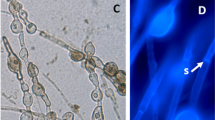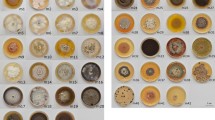Abstract
Aqueous extracts of host plant Casuarina cunninghamiana tissue altered the in vitro growth of its diazotrophic microsymbiont Frankia and a selection of other soil microorganisms. The growth of actinomycetous Frankia strains, 55005, AvcI1, CesI5, CjI82 001, and Cj was stimulated by aqueous extracts of C. cunninghamiana tissue. Green cladodes (photosynthetic branches), unsuberized roots, and suberized roots were more stimulatory than dry cladodes and seed tissue. Aqueous extracts of green cladodes of C. cunninghamiana most stimulated the growth of Casuarina-derived Frankia strains CjI82 001 and 55005. The growth of isolates of soil bacteria Bradyrhizobium japonicum, Arthrobacter globiformis, and Bacillus subtillis and of the soil fungi Penicillium oxalicum and Arthroderma cookiellum was either inhibited or not affected by cladode extracts. Cladode extracts stimulated the growth of the actinomycete Streptomyces albus and the fungus Rhizopus homothallicus. The magnitude (as great as 100%) of the increase in growth caused by tissue extracts for the Casuarina-derived Frankia strains relative to other soil microbes suggests a host-specific enhancement of the microsymbiont.
Similar content being viewed by others
REFERENCES
Baker, D. D. 1987. Relationships among pure cultured strains of Frankia based on host specificity. Physiol. Plant 70:245–248.
Baker, D. D. and Schwintzer, C. R. 1990. Introduction, pp. 365–385, in C. R. Schwintzer and J. D. Tjepkema (eds.). The Biology of Frankia and Actinorhizal Plants. Academic Press, San Diego.
Baker, D. D. and Torrey, J. G. 1980. Characterization of an effective actinorhizal microsymbiont Frankia AvcI1 (Actinomycetales). Can. J. Microb. 26:1066–1071.
Benoit, L. F. and Berry, A. M. 1997. Flavonoid-like compounds from seeds of red alder (Alnus rubra) influence host nodulation by Frankia (Actinomycetales). Physiol. Plant 99:588–593.
Bradford, M. 1976. A rapid and sensitive method for quantification of microgram quantities of protein utilizing the principle of protein-dye binding. Analyt. Biochem. 72:248–254.
Burggraaf, A. J. P. and Shipton, W. A. 1982. Estimates of Frankia growth under various pH and temperature regimes. Plant Soil 69:135–147.
Burleigh, S. H. and Dawson, J. O. 1991. Effects of NaCl and melibiose on growth and sporulation of Frankia strain HFPCcI3. Aust. J. Ecol. 16: 531–535.
Dickie, A. A., Koide, R. T., and Steiner, K. C. 2002. Influences of established trees on myrorrhizas, nutrition, and growth of Quercus rubra seedlings. Ecol. Monogr. 72:505–521.
Diem, H. G., Gauthier, D., and Dommergues, Y. R. 1983. An effective strain of Frankia from Casuarina sp. Can. J. Bot. 61:2815–2821.
Elo, S., Maunuksela, L., Salkinoja-Salonen, M., Smolander, A., and Haahtela, K. 2000. Humus bacteria of Norway spruce stands: Plant growth promoting properties and birch, red fescue and alder colonizing capacity. FEMS Microbiol. Ecol. 31:143–152.
Gauthier, D., Jaffre, T., and Prin, Y. 2000. Abundance of Frankia from Gymnostoma spp. in the rhizosphere of Alphitonia neocaledonica, a non-nodulated Rhamnaceae endemic to New Caledonia. Eur. J. Soil Biol. 36:169–175.
Harborne, J. 1973. Phytochemical Methods. Chapman and Hall, London.
Janczarek, M., Urbanik-Sypniewska, T., and Skorupska, A. 1996. Effects of authentic flavonoids and the exudate of clover root on the growth rate and inducing ability of nod genes of Rhizobium leguminosarum bv. trifolii. Microbiol. Res. 152:93–98.
Kapulnik, Y., Joseph, C. M., and Phillips, D. A. 1987. Flavone limitations to root nodulation and symbiotic nitrogen fixation in alfalfa. Physiol. Plant 84:1193–1196.
Knowlton, S. and Dawson, J. O. 1983. Effects of Pseudomonas cepacia and cultural factors on the nodulation of Alnus rubra roots by Frankia. Can. J. Bot. 61:2887–2882.
Krumholz, G. D., Chval, M. S., McBride, M. J., and Tisa, L. S. 2003. Germination and physiological properties of Frankia spores. Plant Soil 254: 57–67.
Latour, X., Corberand, T. S., Laguerre, G., Allard, F., and Lemanceau, P. 1996. The composition of fluorescent pseudomonad populations associated with roots is influenced by plant and soil type. Appl. Env. Microbiol. 62:2449–2456.
Latour, X., Philippot, L., Corberand, T., and Lemanceau, P. 1999. The establishment of an introduced community of fluorescent pseudomonads in the soil and in the rhizosphere is affected by the soil. FEMS Microbiol. Ecol. 30:163–170.
Lemanceau, P., Corberand, T., Gardan, L., Latour, X., Laguerre, G., Boeufgras, J. M., and Alabouvette, M. 1995. Effect of 2 plant-species, flax (Linum usitatissinum L.) and tomato (Lycopersicon esculentum Mill), on the diversity of soil borne populations of fluorescent pseudomonads. Appl. Env. Microbiol. 61:1004–1012.
Li, C., Lu, K., Trappe, J., and Bollen, W. 1970. Separation of phenolic compounds in alkali hydrolysates of forest soil by thin-layer chromatography. Can. J. Soil Sci. 50:458–460.
Maunuksela, L., Zepp, K., Koivula, T., Zeyer, J., Haahtela, K., and Hahn, D. 1999. Analysis of Frankia populations in three soils devoid of actinorhizal plants. FEMS Microbiol. Ecol. 28:11–21.
Murry, M. A., Fontain, M. S., and Torrey, J. G. 1984. Growth kinetics and nitrogenase induction in Frankia sp. HFPArI3 grown in batch culture. Plant Soil 78:61–78.
Nickel, A. 2000. Population dynamics of Frankia in soil. PhD Dissertation. Swiss Federal Institute of Technology, Zurich.
Paschke, M. W. and Dawson, J. O. 1992. Frankia abundance in soils beneath Betula nigra and other non-actinorhizal woody plants. Acta Oecol. 13:407–415.
Perradin, Y., Mottet, M., and LaLonde, M. 1983. Infuence of phenolics on in vitro growth of Frankia strains. Can. J. Bot. 61:2807–2814.
Sampo, S., Bergero, R., Buffa, G., and LuppiMosca, A. M. 1997. Soil fungal communities in a young and an old Alnus viridis coenosis. Mycologia 89:837–845.
Sayed, F. and Wheeler, C. 1999. Effects of the flavonoid quercetin on the culture and isolation of Frankia from Casuarina root nodules. Folia Mircobiol. 44:59–62.
Sedmak, J. J. and Grossberg, S. E. 1977. A rapid, sensitive, and versatile assay for protein using coomassie brilliant blue G250. Anal. Biochem. 79:544–552.
Selim, S., Delacour, S., and Schwencke, J. 1996. Specific long-chain fatty acids promote optimal growth of Frankia: Accumulation and intracellular distribution of palmitic and propionic acid. Arch. Microbiol. 165:252–257.
Smolander, A. 1990. Frankia populations in soils under different tree species-with special emphasis on soils under Betula pendula. Plant Soil 121:1–10.
Somasegaran, P. and Hoben, H. J. 1985. Methods in legume-Rhizobium technology, p. 273, in NifTAL Project and MIRCEN. University of Hawaii NifTAL Project and MIRCEN, Hawaii.
Tisa, L., McBride, M., and Ensign, J. C. 1983. Studies of growth and morphology of Frankia strains EAN1pec, EuI1c, CpI1, and ACN1ag. Can. J. Bot. 61:2768–2773.
Tzean, S. S. and Torrey, J. G. 1989. Spore germination and the life cycle of Frankia in vitro. Can. J. Microbiol. 35:801–806.
Vergnaud, L., Chaboud, A., Prin., Y., and Rougier, M. 1985. Preinfection events in the establishment of Alnus-Frankia symbiosis: Development of a spot inoculation technique. Plant Soil 87:67–78.
Vogel, C. S. and Dawson, J. O. 1986. in vitro growth of five Frankia isolates in the presence of four phenolic acids and juglone. Soil Biol. Biochem. 18:27–231.
Whitehead, D. 1964. Identification of p-hydroxybenzoic, vanillic, p-coumaric, and ferulic acid in soils. Nature 202:417–419.
Whitehead, D., Dibb, H., and Hartley, R. 1983. Bound phenolic compounds in water extracts of soils, plant roots and leaf litter. Soil Biol. Biochem. 15:133–136.
Wilkinson, K. G., Sivasithamparam, K., Dixon, K. W., Fahy, P. C., and Bradley, J. K. 1994. Identification and characterization of bacteria associated with Western-Australian orchids. Soil Biol. Biochem. 26:137–142.
Wollum, C. T., Youngberg, A. G., and Chichester, F. W. 1968. Relation of previous timber stand age to nodulation of Ceanothus velutinus. For. Sci. 14:114–118.
Zimpfer, J. F., Kaelke, C. M., Smyth, C. A., Hahn, D., and Dawson, J. O. 2003. Frankia inoculation, soil biota, and host tissue amendment influence Casuarina nodulation capacity of a tropical soil. Plant Soil 254: 1–10.
Zimpfer, J. F., Kennedy, G. J., Smyth, C. A., Hamelin, J., Navarro, E., and Dawson, J. O. 1999. Localization of Casuarina-infective Frankia near Casuarina cunninghamiana trees in Jamaica. Can. J. Bot. 77:1248–1256.
Zimpfer, J. F., McCarty, B., Kaelke, C. M., Mulongwe, L., Igual, J. M., Smyth, C. A., and Dawson, J. O. 2002. Casuarina cunninghamiana cladode extracts increase the Frankia infectious capacity of a tropical soil. Symbiosis 33: 73–90.
Author information
Authors and Affiliations
Corresponding author
Rights and permissions
About this article
Cite this article
Zimpfer, J.F., Igual, J.M., McCarty, B. et al. Casuarina cunninghamiana Tissue Extracts Stimulate the Growth of Frankia and Differentially Alter the Growth of Other Soil Microorganisms. J Chem Ecol 30, 439–452 (2004). https://doi.org/10.1023/B:JOEC.0000017987.19225.86
Issue Date:
DOI: https://doi.org/10.1023/B:JOEC.0000017987.19225.86




